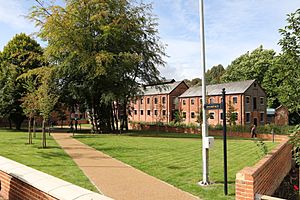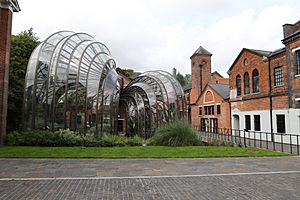Laverstoke Mill facts for kids
Quick facts for kids Laverstoke Mill |
|
|---|---|

Laverstoke Mill
|
|
| Type | Watermill |
| Location | Laverstoke |
| OS grid reference | SU 49244 48641 |
| Area | Hampshire |
|
Listed Building – Grade II
|
|
| Official name: Mill House | |
| Designated | 12 April 1984 |
| Reference no. | 1092686 |
|
Listed Building – Grade II
|
|
| Official name: Former mill cottages at Laverstoke Mill | |
| Designated | 12 April 1984 |
| Reference no. | 1339658 |
|
Listed Building – Grade II
|
|
| Official name: Former wheel house and glazing house at Laverstoke Mill | |
| Designated | 10 January 1953 |
| Reference no. | 1092687 |
| Lua error in Module:Location_map at line 420: attempt to index field 'wikibase' (a nil value). | |

Laverstoke Mill is a historic building complex in England. It sits right by the River Test in Laverstoke, near Overton. This place used to be a busy paper mill.
Today, Laverstoke Mill is home to the famous Bombay Sapphire gin. It has been carefully updated to make gin, including a cool new glasshouse for the special plants used in the gin. This unique glasshouse was designed by Heatherwick Studio.
Contents
History of Laverstoke Mill
From Corn to Paper
Laverstoke Mill has a long and interesting past. It started out as a mill that processed corn. This was a common use for mills back then.
In 1718, a man named Henry Portal bought the site. He decided to change the mill's purpose. He turned it into a paper mill instead of a corn mill.
Printing Money
For many years, Laverstoke Mill made paper. Then, in 1923, something very important happened. The mill started printing bank-notes!
These bank-notes were not just for Britain. They were also for the entire British Empire. This shows how important the mill was at that time.
Laverstoke Mill Today
A Home for Bombay Sapphire Gin
After its long history of making paper and printing money, Laverstoke Mill found a new purpose. It is now used to make Bombay Sapphire gin.
The gin company carefully restored the old buildings. They also added new parts, like the special glasshouses. These glasshouses grow the "botanicals," which are the plants and spices that give gin its unique flavor.
The mill complex includes three buildings that are "Grade II listed." This means they are very old and important. They are protected by law because of their historical value. These buildings are the Mill House, the Mill Cottages, and the Glazing House.
Images for kids





